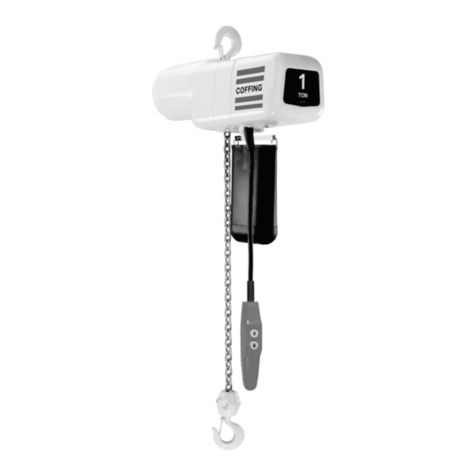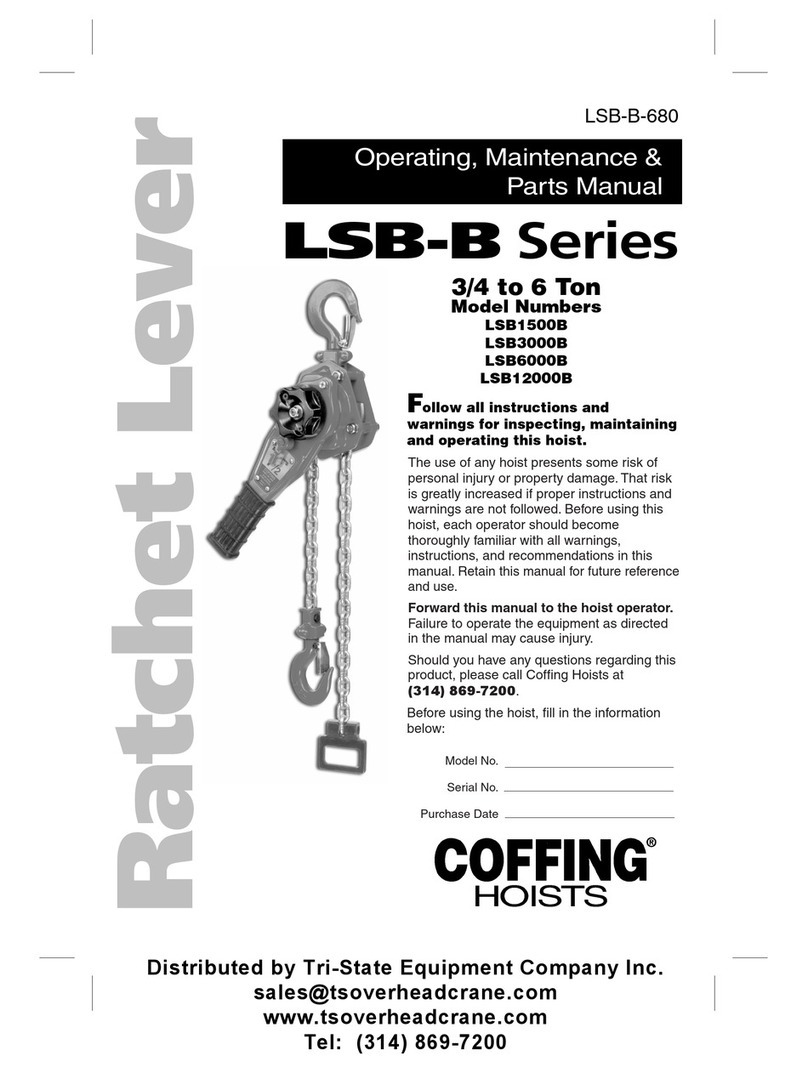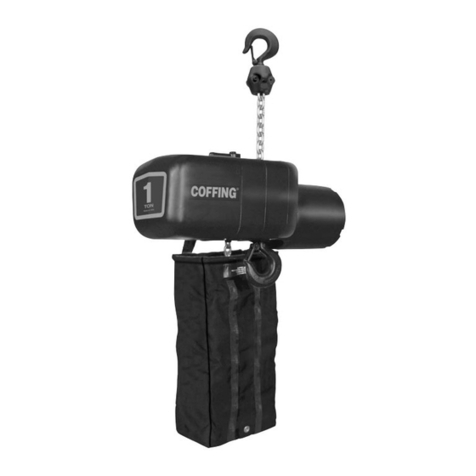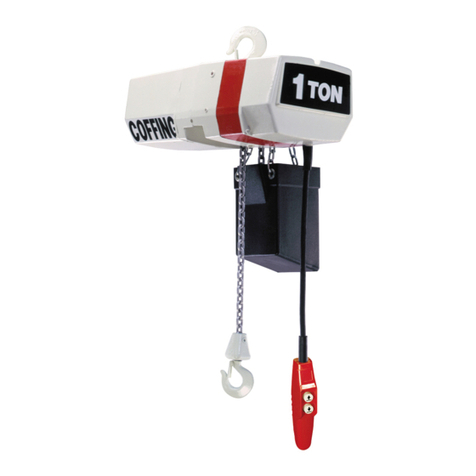INSTALLATION
1. Before installing the hoist, check the following:
a. Make sure all supporting structures and attaching devices
are strong enough to hold your intended loads.If in doubt,
consult a qualified structural engineer.
b. This hoist is equipped with a 3-prong, grounding-type plug
to minimize shock hazards.It must be plugged into a
properly installed and grounded receptacle to maintain
this protection.
c. This hoist is intended for use on a 115 volt, single-phase,
60 Hz power supply.The power supply should be plus or
minus 10% of 115 volts.
d. Installation area must provide operating conditions for the
operator including sufficient room for the operator and
other personnel to stand clear of the load at all times.
e. Make sure that the hook latch closes after hanging the hoist.
2. Before operating the hoist, be sure to observe the following:
a. ALWAYS DISCONNECT HOIST FROM POWER SUPPLY
before removing electrical cover or when making any
electrical connection in the hoist or pushbutton station.
b. Limit Switch Operation. Before placing the hoist in
operation, check for proper upper limit switch operation.
Push the “UP” button, and while the hook is moving
upward, raise the limit switch paddle (Figure 2, Item 35).
The hook should stop immediately. Do not operate the
hoist if the limit switch is not operating properly.
c. Brake Operation. NOTE:Run the hoist with a light load a
few times before lifting the rated load.After lifting a light
load a few times, test the hoist by lifting the rated load.
Check for load hook drift with rated load on the hook.If
hook does not stop within one to two inches when
pushbutton is released, it may be necessary to replace
the brake assembly.
OPERATION
This hoist is designed for safe operation within the limits of its
rated capacity.It is controlled by the“UP” and “DOWN” buttons
of the pushbutton station.Although the Coffing EMW is built
with many features to ensure safety, it is a requirement that a
hoist operator understands safe lifting practices.The following
points must be observed.
1. Do not overload the hoist.
2. Align hoist directly over load.Do not make extreme side
pulls with the hoist.
3. Operate the hoist only in a hanging position with
adequate support.
4. Do not “sling”the load hook and wire rope around the load.
Use an approved sling.
5. Be sure there are no twists or kinks in the wire rope as it
travels into the hoist housing.
6. Lift the load just clear of its supports and stop the hoist to
check for proper brake action.
7. Do not stand beneath a load! Do not move a load in such a
manner as to endanger personnel.
8. Don’t lower into areas where visibility is obscured unless
someone else is guiding the operation.
9. Use common sense at all times when operating a hoist.
10. Do not run hook down so that fewer than two wraps of
cable remain on drum.
11. Lift and lower the load smoothly, avoiding jogging of the
controls or quick reversals.
12. Do not reverse wind cable on drum.If hoist runs in direction
opposite that indicated on pushbutton, cable may be
reverse wound.If this situation occurs, cease using hoist
immediately. Rewind cable in proper direction and inspect
hoist for damage.
13. Do not operate damaged or malfunctioning hoist.
14. The limit switch is an emergency protective device. Do not
use the limit switch to stop the hoist in normal operation.
MAINTENANCE
INSPECTIONS
A planned inspection routine should be established for this
hoist based upon frequency of use, severity of use, and
environmental conditions (Reference ASME Standard B30.16).
All inspections should be performed or overseen by a
designated inspector.Special inspections should be made
following any significant repairs and if the hoist is used more
than 40 hours per week, under adverse environmental
conditions or any operating occurrence leading one to suspect
that the hoist’s capability may have been impaired.
1. Daily Inspection. Inspect the following items daily before
operating the hoist.
a. Check pushbutton station, brake, and limit switch for
proper operation (See INSTALLATION, 2-b & 2-c).
b. Check hooks for deformation, cracks, or chemical
damage.Hooks having more than 1" throat opening
should be replaced, (See Figure 1, page 5).
c. Check for bent or otherwise damaged hook latches.
d. Check wire rope for wear, broken wires, kinks or twists.
e. Check pushbutton cord and power cord for cuts or damage.
2. Quarterly Inspection. Inspect the following items at 90-day
intervals.
a. Check all items under daily inspection.
b. Check for loose bolts, screws and nuts.
c. Inspect for worn, corroded, cracked or distorted parts.
d. Check electrical parts, limit switch and pushbutton station.
3. Annual Inspection. Inspect the following items annually.
a. Check all items under daily and quarterly inspection.
b. Check hooks for cracks by means of a magnetic particle
test or other crack detecting test.
4
Country Club Road
P.O. Box 779
Wadesboro, NC 28170 USA
TEL: (800) 477-5003
FAX: (800) 374-6853
Always disconnect power source before working on
or near a hoist or its connected load. If the power
disconnect point is out of sight, lock it in the open
position and tag to prevent unexpected application
of power.
































